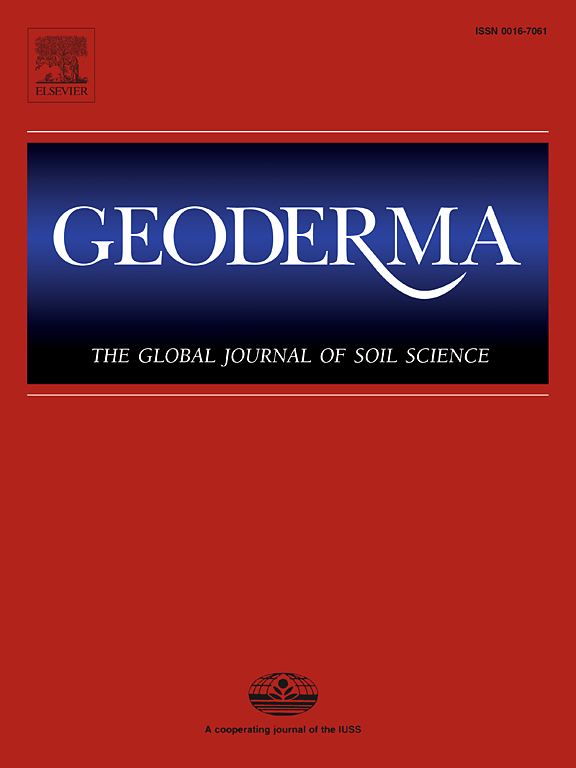Responses of microbial respiration rate and active bacterial communities to antecedent soil moisture on the Loess Plateau
IF 5.6
1区 农林科学
Q1 SOIL SCIENCE
引用次数: 0
Abstract
Previous studies on microbial respiration responses to soil moisture have primarily focused on the influence of current moisture conditions, largely overlooking the role of antecedent soil moisture and its effects on the soil carbon (C) pool. In this study, we investigated the effect patterns of antecedent moisture on bacterial 16S rRNA composition, microbial respiration and the soil extractable organic carbon (EOC) pool by examining soils subjected to rewetting, drying and maintenance at constant moisture conditions. Bacterial community composition depended on both antecedent and current soil moisture. Specifically, rewetting decreased the relative abundance of Actinobacteriota and increased that of Proteobacteria, Myxococcota, Acidobacteriota and Gemmatimonadota, while that of Actinobacteriota, Proteobacteria, Chloroflexi and Entotheonellaeota increased after drying. The drying and rewetting treatments significantly affected substrate availability, as rewetting from antecedent drought facilitated the enrichment of soil EOC and induced a pulse in the respiration rate compared to drying from antecedent wetting. Additionally, most of the rewetting treatments increased the relative abundances of aromatic compounds. Soil moisture contents finally at 80 % water holding capacity (WHC) were most suitable for microbial respiration. Except for extreme drying, drying and rewetting treatments reduced C loss as drying promoted the integration of organic matter into the EOC pool via the desorption of aromatic substances and/or the lysis of microbial cells, which stimulated microbial respiration. The mechanistic and quantitative insights into the effects of antecedent moisture conditions on the soil C dynamic provided by this study will help reduce uncertainty in predicting soil C using current models.
黄土高原土壤微生物呼吸速率和活性细菌群落对前期土壤水分的响应
以往关于微生物呼吸对土壤水分响应的研究主要集中在当前水分条件的影响上,而忽略了土壤前态水分及其对土壤碳库的影响。在本研究中,我们通过研究在恒定水分条件下进行再湿润、干燥和维持的土壤,研究了前水分对细菌16S rRNA组成、微生物呼吸和土壤可提取有机碳(EOC)库的影响模式。细菌群落组成依赖于以前和现在的土壤湿度。其中,再湿润降低了放线菌门的相对丰度,增加了变形菌门、黏菌门、酸杆菌门和双胞菌门的相对丰度,而干燥后放线菌门、变形菌门、绿杆菌门和内胆菌门的相对丰度增加。干燥和再润湿处理显著影响基质有效性,因为与前润湿处理相比,前干旱处理的再润湿处理促进了土壤EOC的富集,并引起呼吸速率的脉冲。此外,大多数复湿处理增加了芳香族化合物的相对丰度。土壤含水量在持水量的80%时最适宜微生物呼吸。除极端干燥外,干燥和再湿处理减少了碳损失,因为干燥促进了有机质通过芳香物质的解吸和/或微生物细胞的裂解进入EOC池,从而刺激了微生物的呼吸作用。本研究提供的前期水分条件对土壤C动态影响的机制和定量见解将有助于减少使用当前模型预测土壤C的不确定性。
本文章由计算机程序翻译,如有差异,请以英文原文为准。
求助全文
约1分钟内获得全文
求助全文
来源期刊

Geoderma
农林科学-土壤科学
CiteScore
11.80
自引率
6.60%
发文量
597
审稿时长
58 days
期刊介绍:
Geoderma - the global journal of soil science - welcomes authors, readers and soil research from all parts of the world, encourages worldwide soil studies, and embraces all aspects of soil science and its associated pedagogy. The journal particularly welcomes interdisciplinary work focusing on dynamic soil processes and functions across space and time.
 求助内容:
求助内容: 应助结果提醒方式:
应助结果提醒方式:


